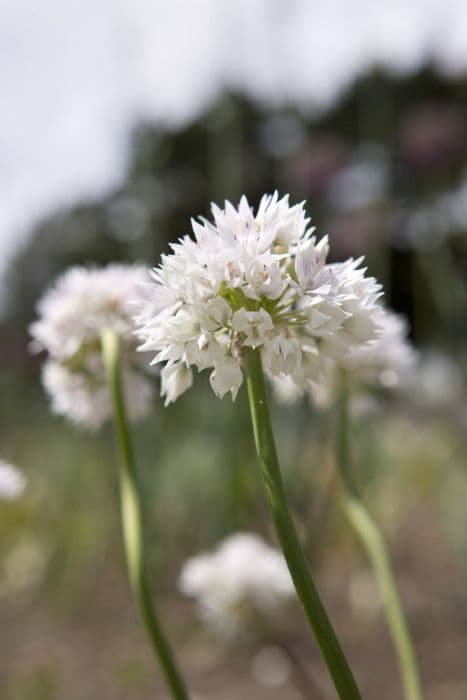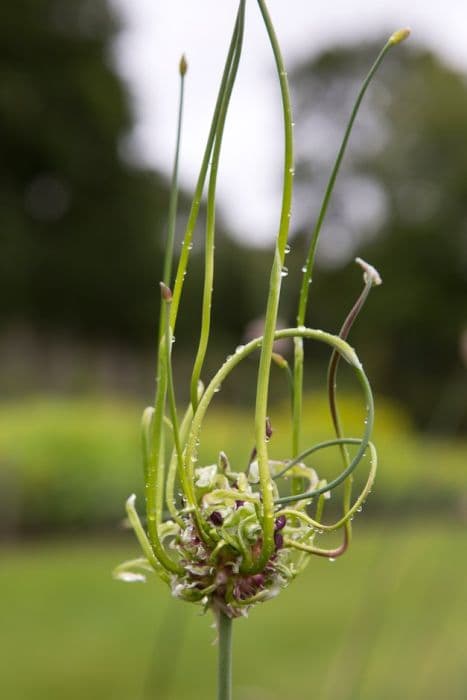Nodding Onion Allium cernuum

ABOUT
The plant known as nodding onion is recognized for its distinctive flowering habit. The plant typically produces attractive, clump-forming foliage consisting of long, narrow, and grass-like leaves. The foliage emerges from a bulb nestled in the soil. The most striking feature is its flower head, which is an umbel, meaning that all the flower stalks arise from a common point and form a sort of umbrella-shaped floral display. However, as its common name suggests, the umbel of the nodding onion tends to droop or nod, giving it a unique and graceful appearance. Delicate bell-shaped flowers appear on each individual flower stalk within the umbel. These blossoms usually exhibit a soft pink to lavender color, occasionally leaning toward white. What makes the flowers exceptionally appealing is their arrangement at the tip of each flower stalk, bending downward as if in a poised bow. After the flowering season, the plant produces seeds which are also held in the same nodding clusters that previously exhibited the flowers. The seed capsules mature as the flowering ends, signaling the end of the plant's reproductive cycle for the season. Throughout its growing season, nodding onion presents a charming addition to gardens, attracting pollinators such as bees and butterflies with its nectar-rich blooms. Its aesthetic allows it to be a favored choice for naturalized areas, rock gardens, and borders where a soft, natural appearance is desired.
About this plant
 Names
NamesSynonyms
Nodding Onion, Lady's Leek, Wild Onion
Common names
Allium allegheniense, Allium oxyphilum, Allium cernuum var. obtusum.
 Toxicity
ToxicityTo humans
The plant Allium cernuum, commonly known as nodding onion, is not considered toxic to humans. In fact, it is often used as a food source and has edible parts, including the bulbs, flowers, and stems. However, as with any plant, it is possible for individuals to have allergic reactions or sensitivities, so it should be consumed in moderation, especially by those who have not eaten it before.
To pets
For pets, particularly cats and dogs, Allium cernuum, or nodding onion, can be toxic. The Allium family contains compounds that can be harmful to pets if ingested in large quantities. The consumption of nodding onion by pets can lead to symptoms such as gastrointestinal upset, lethargy, abdominal pain, and more seriously, hemolytic anemia which is the destruction of red blood cells. The toxicity level and potential consequences depend on the amount consumed and the size of the pet. If you suspect your pet has ingested nodding onion, it is important to seek veterinary care promptly.
 Characteristics
CharacteristicsLife cycle
Perennials
Foliage type
Deciduous
Color of leaves
Green
Flower color
Pink
Height
1-2 feet (30-60 cm)
Spread
0.5-1 feet (15-30 cm)
Plant type
Bulb
Hardiness zones
4-8
Native area
North America
Benefits
 General Benefits
General Benefits- Edible Parts: Allium cernuum, commonly known as nodding onion, has edible bulbs, leaves, and flowers that can be used in cooking and salads, providing a mild, yet flavorful onion taste.
- Ornamental Value: The plant adds ornamental appeal to gardens with its attractive clusters of nodding pink and lavender flowers, making it a popular choice for ornamental gardens and naturalized areas.
- Attracts Pollinators: Nodding onion is known for attracting a variety of pollinators, including bees and butterflies, which are crucial for the pollination of many other plants.
- Drought Resistance: Being drought-tolerant once established, it's suitable for xeriscaping and can thrive with minimal watering, which is beneficial in arid and semi-arid regions.
- Low Maintenance: This species requires minimal care beyond initial establishment, making it a low-maintenance option for gardeners of all skill levels.
- Native Plant Advantages: As a native to North America, it has adapted to local climates and supports local wildlife, contributing to the preservation of regional biodiversity.
- Culinary Use: The plant’s leaves and bulbs are often used in culinary dishes and can serve as a substitute for onions or chives, providing unique flavors to various recipes.
- Erosion Control: The nodding onion's root system helps stabilize soil and prevent erosion, especially on slopes or in areas prone to soil degradation.
- Deer and Rabbit Resistant: The plant is typically not preferred by deer and rabbits, reducing the risk of damage from these animals in the garden.
- Companion Planting: It can be planted alongside other species to create beneficial plant communities that support each other’s growth and health.
- Seasonal Interest: Nodding onion has a long blooming period that extends through the summer months, adding continuous interest and color to gardens during the growing season.
- Seed Production: The plant readily produces seeds, which can be collected for propagation or to encourage natural spreading within the landscape.
 Medical Properties
Medical Properties- Antibacterial: Allium cernuum, commonly known as Nodding Onion, may have substances that exhibit antibacterial activity.
- Antifungal: Components found in Nodding Onion could potentially demonstrate antifungal properties.
- Antioxidant: This plant may contain antioxidants, which help protect cells from damage caused by free radicals.
 Air-purifying Qualities
Air-purifying QualitiesThis plant is not specifically known for air purifying qualities.
 Other Uses
Other Uses- The nodding onion can be used as a butterfly and pollinator attractant in gardens, because it produces nectar-rich flowers that entice a wide variety of pollinating insects.
- The strands of nodding onion can serve as natural twine or thread because they are fibrous and can be braided or twisted for use in traditional crafts.
- As an ornamental plant, the nodding onion provides aesthetic appeal to rock gardens and is often used for its graceful, drooping flower heads that add movement and interest.
- The plant is suitable for erosion control on slopes due to its root system that helps hold the soil in place while adding beauty to challenging landscapes.
- Nodding onion can be planted to create a natural border or edge in a garden setting because it forms neat clumps that define garden spaces.
- The bulbs of the nodding onion, when crushed, can be used as a natural repellent for pests like moths and squirrels in the garden.
- In dyeing, the plant parts of the nodding onion can yield a range of colors from greens to browns depending on the mordant used in the dye bath.
- When dried and included in floral arrangements, the unique shape of the nodding onion's flower heads can provide an exotic touch to bouquets and displays.
- For educational purposes, the nodding onion can be used in botanical studies to help students learn about plant structure and pollinator relationships.
- The nodding onion can be utilized in a culinary context as a seasoning or garnish due to its mild onion flavor, which is less intense than common culinary onions.
Interesting Facts
 Feng Shui
Feng ShuiThe Nodding Onion is not used in Feng Shui practice.
 Zodiac Sign Compitability
Zodiac Sign CompitabilityThe Nodding Onion is not used in astrology practice.
 Plant Symbolism
Plant Symbolism- Humility: Allium cernuum, commonly known as Nodding Onion, tends to have a bowed head, which is often perceived as a symbol of modesty or humility.
- Unity: The spherical shape of the Nodding Onion's inflorescence represents oneness and unity, reflecting how each individual floret comes together to form a complete, circular cluster.
- Patience: The Nodding Onion is known for its growth pattern and the gradual unveiling of its blossoms, symbolizing the virtue of patience in life's unfolding.
- Prosperity: Due to its vigorous growth and reproductive success, it's often associated with abundance and prosperity.
- Resilience: Nodding Onions can thrive in a variety of conditions, symbolizing adaptability and the ability to overcome adversity.
 Water
WaterNodding onion requires regular watering, especially during the growing season. The soil should be kept evenly moist but not waterlogged. Depending on the climate, this could mean watering once a week with about one to two inches of water. In hotter, drier conditions, you may need to water more frequently, whereas in cooler, wetter climates, less frequent watering may be necessary. Always check the top inch of soil for dryness before watering to avoid over-watering, which can lead to root rot.
 Light
LightNodding onion thrives best in full sun to partial shade. The ideal spot is one where it receives at least six hours of direct sunlight daily, but it can also tolerate some light afternoon shade. Avoid placing it in deep shade, as this can hinder flowering and weaken the plant.
 Temperature
TemperatureNodding onion is hardy and can survive in a range of temperatures. It can withstand winter conditions as cool as -40 degrees Fahrenheit and prefers a temperate climate during the growing season. The ideal growing temperatures are between 60 and 70 degrees Fahrenheit, which encourages healthy growth and flowering.
 Pruning
PruningNodding onion benefits from deadheading, which is the removal of spent flowers to encourage further blooming. Pruning is generally not required, but if desired for aesthetic reasons, trim back any yellowing or dead foliage during the growing season. The best time for pruning is after it flowers, as this can help promote a tidy appearance and potentially spur a second bloom.
 Cleaning
CleaningNot needed
 Soil
SoilNodding onion prefers well-draining soil with a rich organic content. A mix of loamy soil, peat, and sand in equal parts works well for growth. The ideal soil pH should be between 6.0 and 7.0 to ensure the plant thrives.
 Repotting
RepottingNodding onion rarely needs repotting. It is typically repotted if the bulbs become overcrowded, usually every 3-4 years, to ensure continued health and vigor.
 Humidity & Misting
Humidity & MistingNodding onion is not particularly sensitive to humidity levels and adapts well to the ambient outdoor humidity in most climates where it can naturally grow.
 Suitable locations
Suitable locationsIndoor
Use bright light, poor-soil, water sparingly for indoor nodding onion.
Outdoor
Full sun to part shade, moist soil, divide every 3-4 years.
Hardiness zone
4-8 USDA
 Life cycle
Life cycleAllium cernuum, commonly known as nodding onion, begins its life cycle as a seed that germinates in late winter to early spring. Upon germination, the seed develops into a small bulb that sends up slender, grass-like leaves, gradually forming a clump. Through spring, it grows and stores energy in its bulb until early to midsummer, when it produces distinctive nodding flower heads composed of pink or white flowers that attract pollinators. After flowering, the plant sets seed, which matures by late summer to early fall and is dispersed, completing the reproductive cycle. The foliage of the nodding onion dies back as the plant enters dormancy over the winter, with the bulb surviving underground to begin a new growth cycle the following spring. While perennials, individual plants might not live for many years, but the nodding onion can persist in a location through self-seeding and bulb division.
 Propogation
PropogationPropogation time
Spring to Summer
The nodding onion, known botanically as Allium cernuum, is commonly propagated through seed. The most popular method of propagation for this plant involves collecting the seeds when the plant's seed heads dry out, which usually occurs in late summer or early fall. Seeds can be sown directly into the soil where they will undergo a period of cold stratification naturally over winter, which is necessary for germination. Alternatively, gardeners can mimic this cold period by placing the seeds in moistened sand or a mix of peat and perlite inside a sealed plastic bag, and then refrigerating them for about two months. After this period, the seeds can be sown in containers or a nursery bed indoors under grow lights or in a greenhouse. With spring's warmer temperatures, the seeds will germinate, and once the seedlings are sufficiently developed and the risk of frost has passed, they can be transplanted into the garden.








